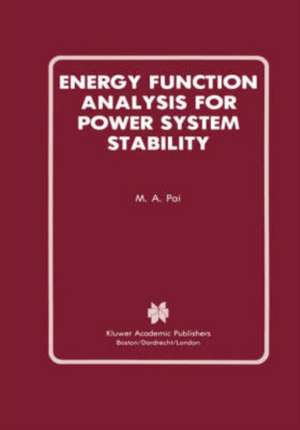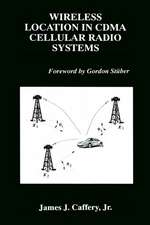Energy Function Analysis for Power System Stability: Power Electronics and Power Systems
Autor M.A. Paien Limba Engleză Hardback – 31 aug 1989
| Toate formatele și edițiile | Preț | Express |
|---|---|---|
| Paperback (1) | 1653.54 lei 6-8 săpt. | |
| Springer Us – 22 ian 2012 | 1653.54 lei 6-8 săpt. | |
| Hardback (1) | 1660.95 lei 6-8 săpt. | |
| Springer Us – 31 aug 1989 | 1660.95 lei 6-8 săpt. |
Din seria Power Electronics and Power Systems
- 18%
 Preț: 944.19 lei
Preț: 944.19 lei -
 Preț: 487.37 lei
Preț: 487.37 lei - 20%
 Preț: 630.01 lei
Preț: 630.01 lei - 15%
 Preț: 648.56 lei
Preț: 648.56 lei - 15%
 Preț: 643.84 lei
Preț: 643.84 lei - 18%
 Preț: 1113.89 lei
Preț: 1113.89 lei - 18%
 Preț: 1120.99 lei
Preț: 1120.99 lei - 18%
 Preț: 950.33 lei
Preț: 950.33 lei - 18%
 Preț: 1981.53 lei
Preț: 1981.53 lei - 15%
 Preț: 638.43 lei
Preț: 638.43 lei - 18%
 Preț: 940.87 lei
Preț: 940.87 lei - 15%
 Preț: 637.46 lei
Preț: 637.46 lei - 18%
 Preț: 949.55 lei
Preț: 949.55 lei - 18%
 Preț: 953.65 lei
Preț: 953.65 lei - 18%
 Preț: 953.97 lei
Preț: 953.97 lei - 18%
 Preț: 944.67 lei
Preț: 944.67 lei - 15%
 Preț: 634.32 lei
Preț: 634.32 lei - 18%
 Preț: 832.78 lei
Preț: 832.78 lei - 18%
 Preț: 945.30 lei
Preț: 945.30 lei - 18%
 Preț: 1239.85 lei
Preț: 1239.85 lei - 15%
 Preț: 642.18 lei
Preț: 642.18 lei - 18%
 Preț: 1656.08 lei
Preț: 1656.08 lei - 18%
 Preț: 953.65 lei
Preț: 953.65 lei - 18%
 Preț: 1554.09 lei
Preț: 1554.09 lei - 18%
 Preț: 1657.03 lei
Preț: 1657.03 lei - 18%
 Preț: 951.47 lei
Preț: 951.47 lei - 18%
 Preț: 888.31 lei
Preț: 888.31 lei - 18%
 Preț: 1219.01 lei
Preț: 1219.01 lei - 18%
 Preț: 893.53 lei
Preț: 893.53 lei - 18%
 Preț: 942.94 lei
Preț: 942.94 lei - 18%
 Preț: 1110.24 lei
Preț: 1110.24 lei - 15%
 Preț: 641.85 lei
Preț: 641.85 lei
Preț: 1660.95 lei
Preț vechi: 2025.56 lei
-18% Nou
Puncte Express: 2491
Preț estimativ în valută:
317.86€ • 345.15$ • 267.00£
317.86€ • 345.15$ • 267.00£
Carte tipărită la comandă
Livrare economică 22 aprilie-06 mai
Preluare comenzi: 021 569.72.76
Specificații
ISBN-13: 9780792390350
ISBN-10: 0792390350
Pagini: 240
Ilustrații: XII, 240 p.
Dimensiuni: 178 x 254 x 16 mm
Greutate: 0.66 kg
Ediția:1989
Editura: Springer Us
Colecția Springer
Seria Power Electronics and Power Systems
Locul publicării:New York, NY, United States
ISBN-10: 0792390350
Pagini: 240
Ilustrații: XII, 240 p.
Dimensiuni: 178 x 254 x 16 mm
Greutate: 0.66 kg
Ediția:1989
Editura: Springer Us
Colecția Springer
Seria Power Electronics and Power Systems
Locul publicării:New York, NY, United States
Public țintă
ResearchCuprins
1 Power System Stability in Single Machine System.- 1.1 Introduction.- 1.2 Statement of the Stability Problem.- 1.3 Mathematical Formulation of the Problem.- 1.4 Modeling Issues.- 1.5 Motivation Through Single Machine Infinite Bus System.- 1.6 Chapter Outline.- 2 Energy Functions for Classical Models.- 2.1 Introduction.- 2.2 Internal Node Representation.- 2.3 Energy Functions for Internal Node Models.- 2.4 Individual Machine and other Energy Functions.- 2.5 Structure Preserving Energy Functions.- 2.6 Alternative Form of the Structure Preserving Energy Function.- 2.7 Positive Definiteness of the Energy Integral.- 2.8 Tsolas-Araposthasis-Varaiya Model.- 3 Reduced Order Energy Functions.- 3.1 Introduction.- 3.2 Individual Machine and Group Energy Function.- 3.3 Simplified Form of the Individual Machine Energy Function.- 3.4 Cutset Energy Function.- 3.5 Example of Cutset Energy Function.- 3.6 Extended Equal Area Criterion (EEAC).- 3.7 The Quasi Unstable Equilibrium Point (QUEP) Method.- 3.8 Decomposition-Aggregation Method.- 3.9 Time Scale Energies.- 4 Energy Functions with Detailed Models of Synchronous Machines and Its Control.- 4.1 Introduction.- 4.2 Single Machine System With Flux Decay Model.- 4.3 Multi-Machine Systems With Flux Decay Model (Method of Parameter Variations).- 4.4 Lyapunov Functions for Multi-Machine Systems With Flux Decay Model.- 4.5 Multi-Machine Systems With Flux Decay Models and AVR.- 4.6 Energy Functions With Detailed Models.- 4.7 Lyapunov Function for Multi-Machine Systems With Flux Decay and Nonlinear Voltage Dependent Loads.- 5 Region of Stability in Power Systems.- 5.1 Introduction.- 5.2 Characterization of the Stability Boundary.- 5.3 Region of Stability.- 5.4 Method of Hyperplanes and Hypersurfaces.- 5.5 Potential Energy Boundary Surface (PEBS) Method.- 5.6 Hybrid Method Using the Gradient System.- 6 Practical Applications of the Energy Function Method.- 6.1 Introduction.- 6.2 The Controlling u.e.p. Method.- 6.3 Modifications to the Controlling u.e.p. Method.- 6.4 Potential Energy Boundary Surface (PEBS) Method.- 6.5 Mode of Instability (MOI) Method.- 6.6 Dynamic Security Assessment.- 7 Future Research Issues.- Appendix A 10 Machine 39 Bus System Data.- References.






















